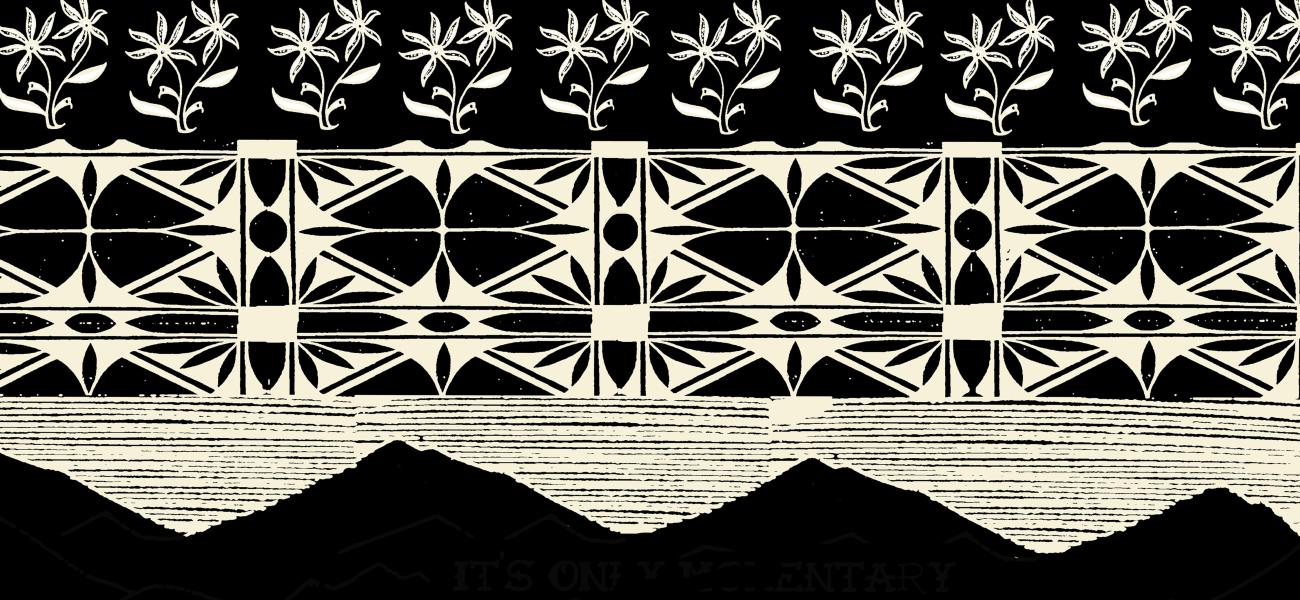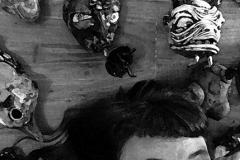It's Only Momentary
Bianka Groves is a potter. Sonny De La Cruz is a tattoo artist. They met online, becoming familiar with the other’s artwork, political views, and interests through Instagram stories in 2020. Both call New Mexico home, and both eyeroll at the state’s motto “Land of Enchantment” while simultaneously acknowledging the truth therein. To slap a motto on any experience is a limit neither would want to assume, regardless of how apropos the phrase might be. Our conversation broached their burgeoning studio collaboration and the journey to their mutually distinct aesthetics. We even talked about how both tattooer and potter have a conversation between surface and form. An easy parallel to spot for certain, but it was interesting to recognize the emergent truth that arose from the familiar topic: regardless of medium, rules learned through foundational training can become restrictions if an artist is not listening to their own creative voice as it matures. One of the more salient points of our conversation was around the idea of permanence, a concept both makers have a refreshing perspective on, and their view has stayed with me weeks after our visit.
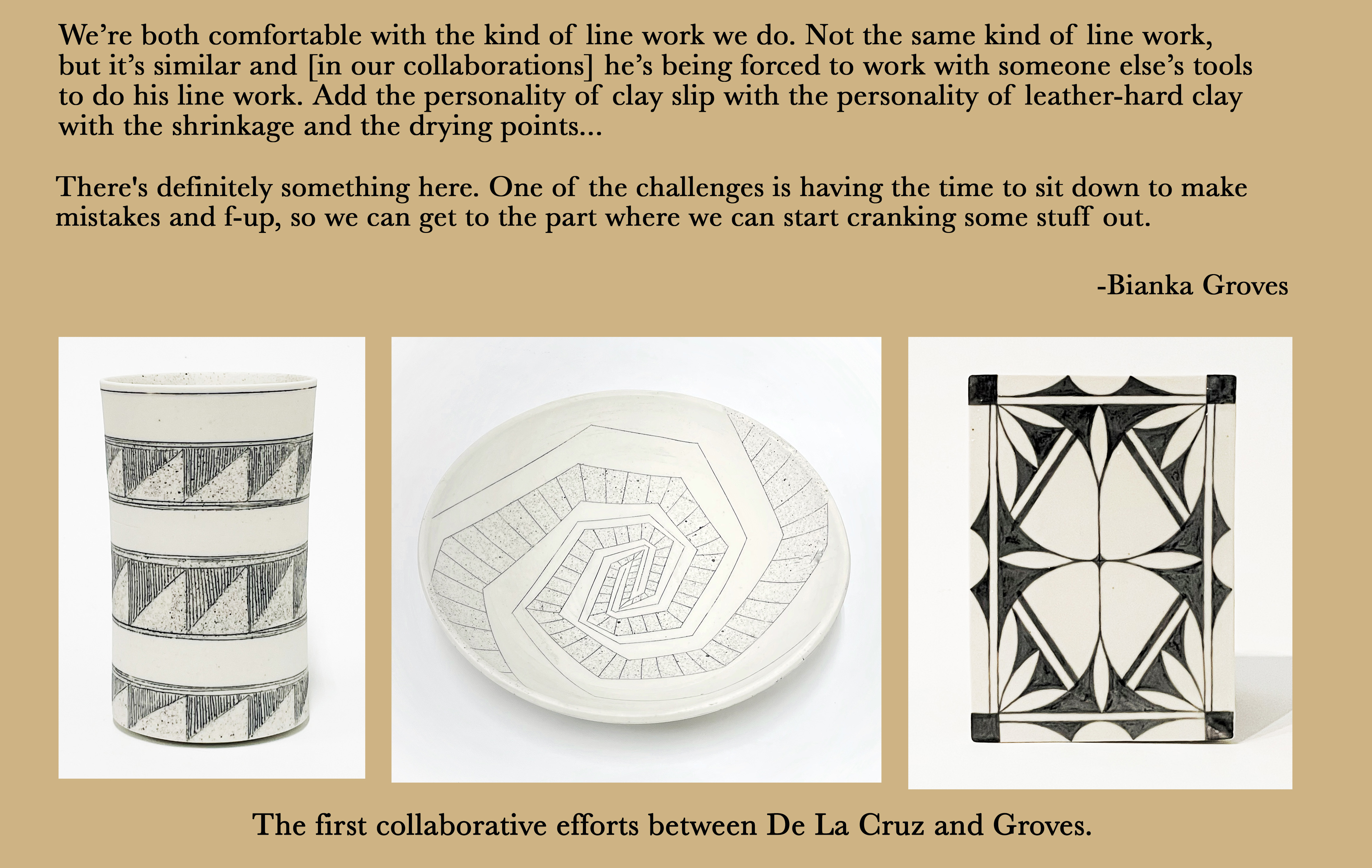
Maybe they are two of the humblest individuals I have ever met, able to understand and appreciate their insignificance in the great scheme of things and time. But that’s a hard contest to win, deciding who is more humble. Bianka’s vessels stand quietly proud and elegant. Volumes of porcelain incised with black lines suggesting (sometimes depicting) a rugged landscape with traces of her process – a smudged layer of history. De La Cruz’s clean and flowing tattooed lines are minimal, but somehow elaborate. They are unwaveringly bold in their repetition and geometry. Distillations of nature translated through his lens, there is enough visual information to build a new narrative while being anchored in history.
Maybe the open landscape of the desert surrounding them taught them to pull back from any given situation and adjust their perspectives before making snap judgements. Maybe hours of honing their individual crafts built a muscle in each of them – a muscle that leads a human to examine what’s “on the other hand.” Maybe such recalibration was an inherent trait and the physicality of the New Mexican landscape, pushing the horizon ever back toward infinity, simply made pre-existing truths about how concepts are defined resonate with them tangibly. Whatever the reason, New Mexico is where they are finding themselves and it is where they found each other.
Bianka has chosen this place after living in many other places.
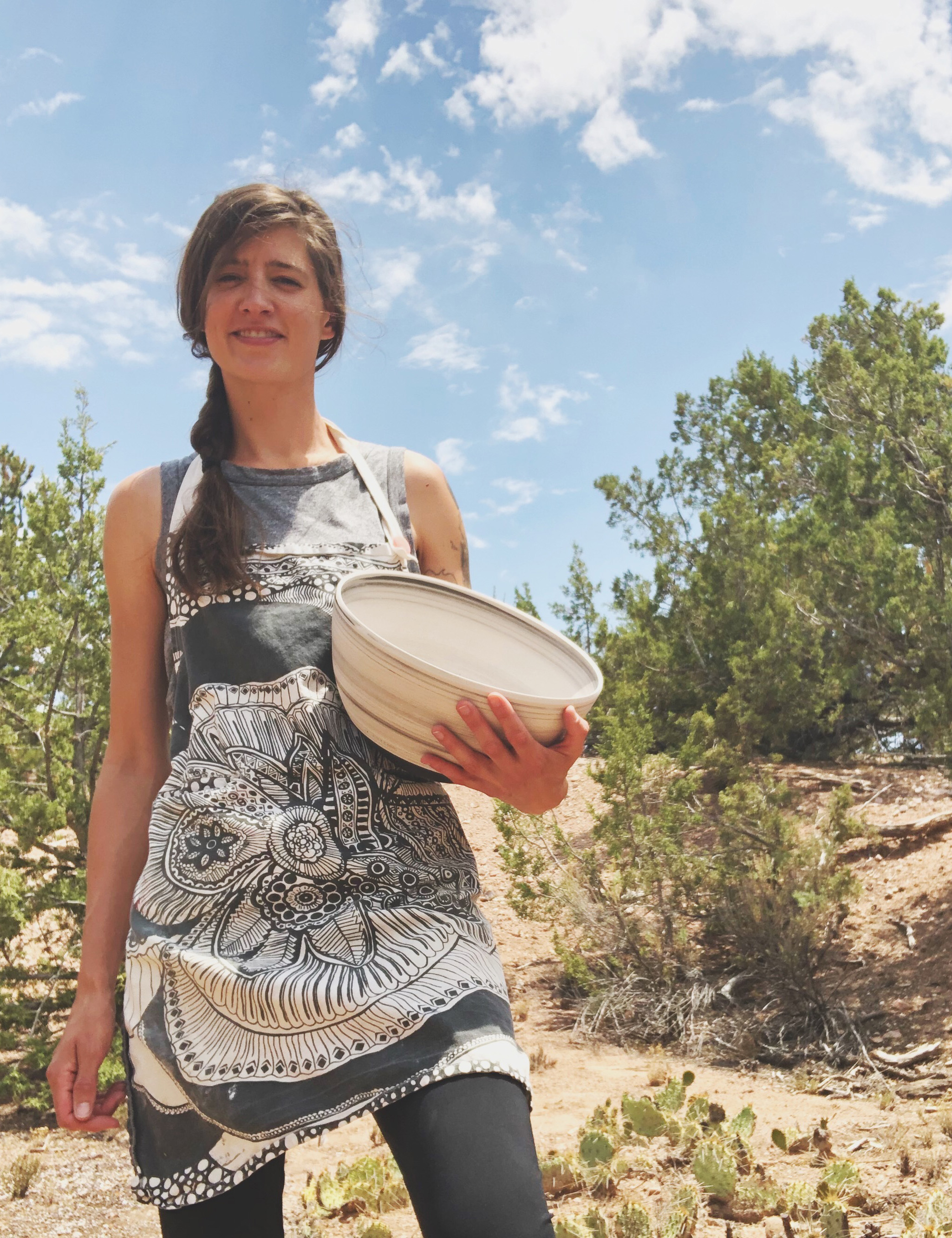
I've lived in small, nothing towns between DC, Baltimore, Minneapolis, the Midwest. I have lived in Pittsburgh, the West Coast – but I have always felt I didn't quite fit in anywhere. And it wasn't necessarily bad. It was like, "Okay, this is good for now. This is a pit stop for now. Everybody I love is in this city or that city. I'm going to check it out for a little while." And it was good – until I started coming regularly to New Mexico. There's something here that is raw and wild. It makes you check yourself as a human being. It makes you focus on your surroundings and impacts who you are. I'm an introvert. I like going to big cities occasionally, but I feel less alone here in New Mexico, surrounded by rocks and really short trees and sand and dirt. There's just something about this place where I feel totally welcomed and absolutely unwelcomed at the exact same time. I'm more conscious of who I am here. It’s not a negative or a positive thing. I just feel at home here. It's different than anywhere else.
And while Sonny was raised in New Mexico, he traveled away to live elsewhere several times, finally returning with intention, appreciation, and purpose.

I mean that was huge. The coming back and the sort of rediscovering with a different eye and a different attitude – hopefully, a more mature mindset. Learning to appreciate a lot of the things I never really noticed about New Mexico in the first place, like the outdoors. I can't say that I disliked the outdoors, but I definitely didn't take advantage of it quite as much as I do now. More than that though, while I was away I started to question my cultural identity (or the lack thereof). My questions were based on the way the public schools educated us on who we were as brown people. I felt like my education led my interests growing up; it led my interests in directions that weren't necessarily ‘me.’ There were things I would see and maybe emulate or enjoy – models I would want to be more like. But coming back, I don’t have any real fears about having questions of identity in my head and seeking out answers. They told us we had nothing to do with the diversity of traditions in New Mexico. Basically, it was – you're a Mexican, you have nothing to do with those Indians. It was never said, but that was my takeaway. Growing up, I was like, "Okay, well, I'm Mexican, and there are these people that are Spaniards, and I have nothing to do with them. Then there's this indigenous population; we have nothing to do with them. I'm a Mexican." That couldn't be anything further from the truth. So, in a way, I got angry, you know? I felt I'd been cheated. I was taught that I am a different version of who I actually am. As I started to look at this and try to recreate things by exploring styles from different cultures – I'm [defining my cultural identity] with a completely different motivation now, one I feel is genuine. I know it wouldn't be the same in any other part of the country, because I would be around a different people. This is … this is where I'm from and that never really meant anything to me before. I think that's part of why in the past five or six years I've been creating things I'm actually proud of. Every once in a while, I'll call myself an artist.
As their friendship grew, a romance blossomed between the potter and the tattoo artist. She introduced him to her love of paddling on rivers and reservoirs. He introduced her to his love of biking. They both are lovers of the canine. Sonny has, possibly, the oldest and most chill chihuahua named Donut. Bianka’s long-time companion – who is not a fan of water, but loves to hike in the desert – is a sweet bouvier named Muddy. They have also been creating in their respective fields for long enough to have developed their own voice – their own aesthetic. A crossover was inevitable.
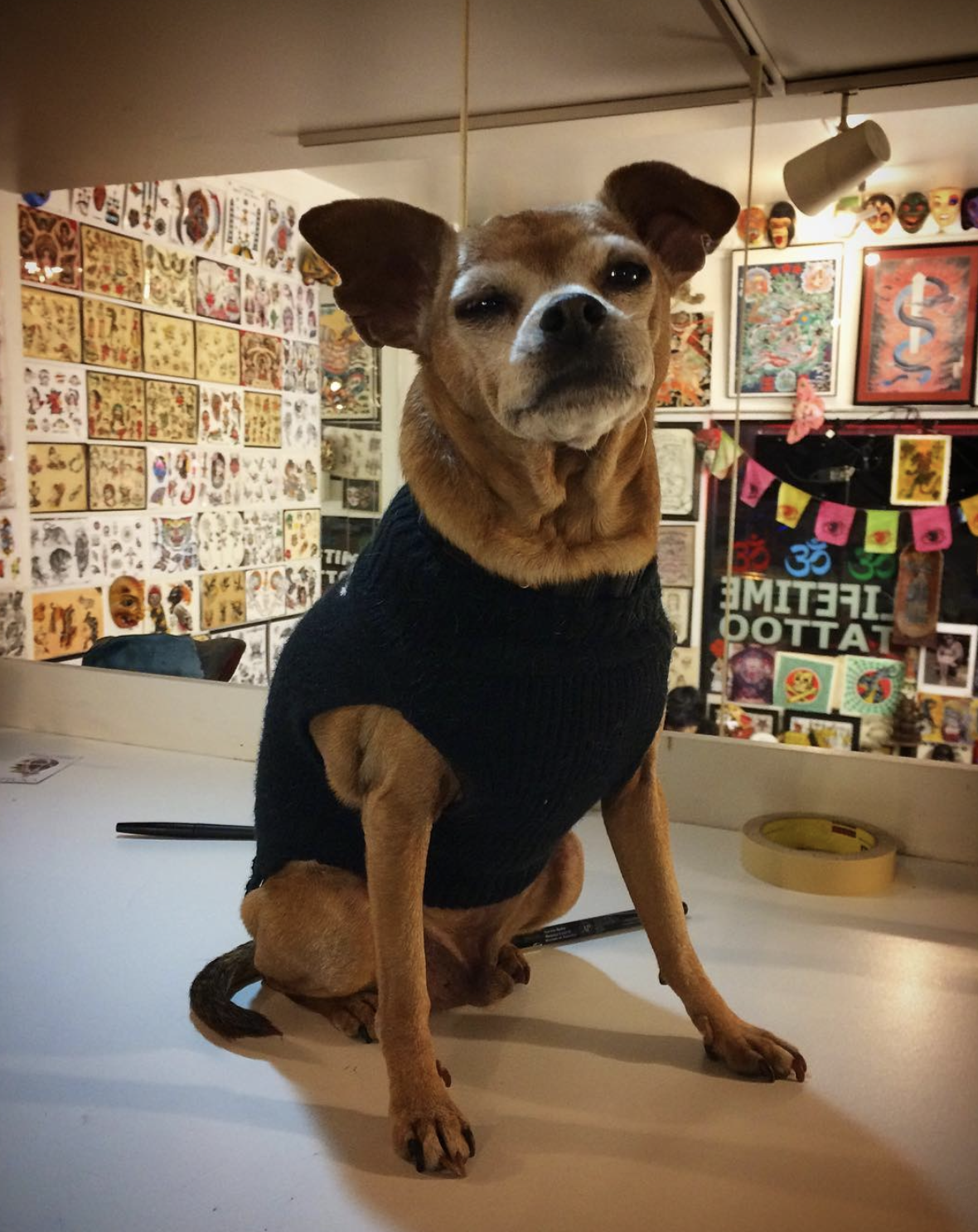
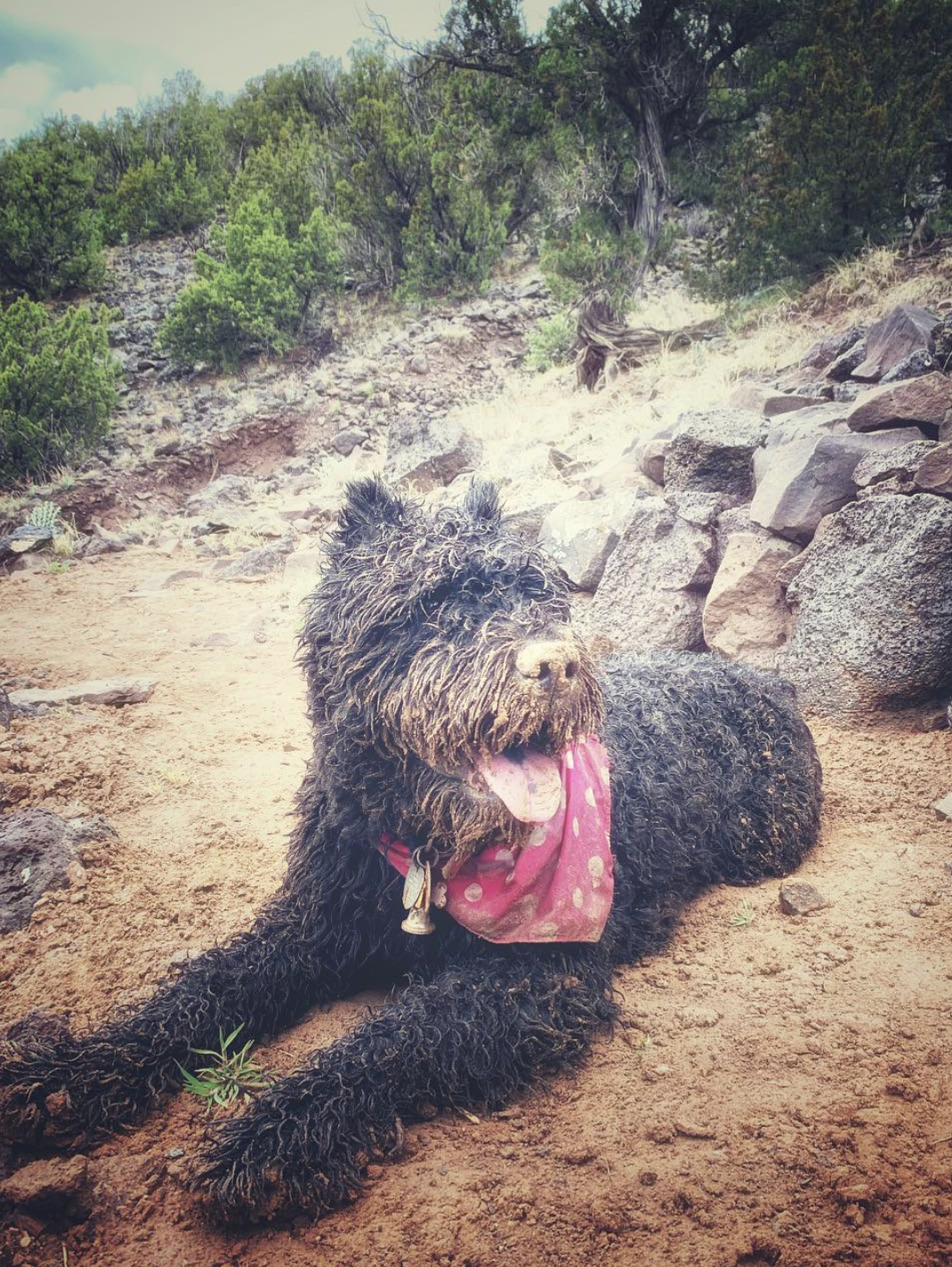
They were just voicing opinions on Instagram, and then they started messaging each other with encouragement:
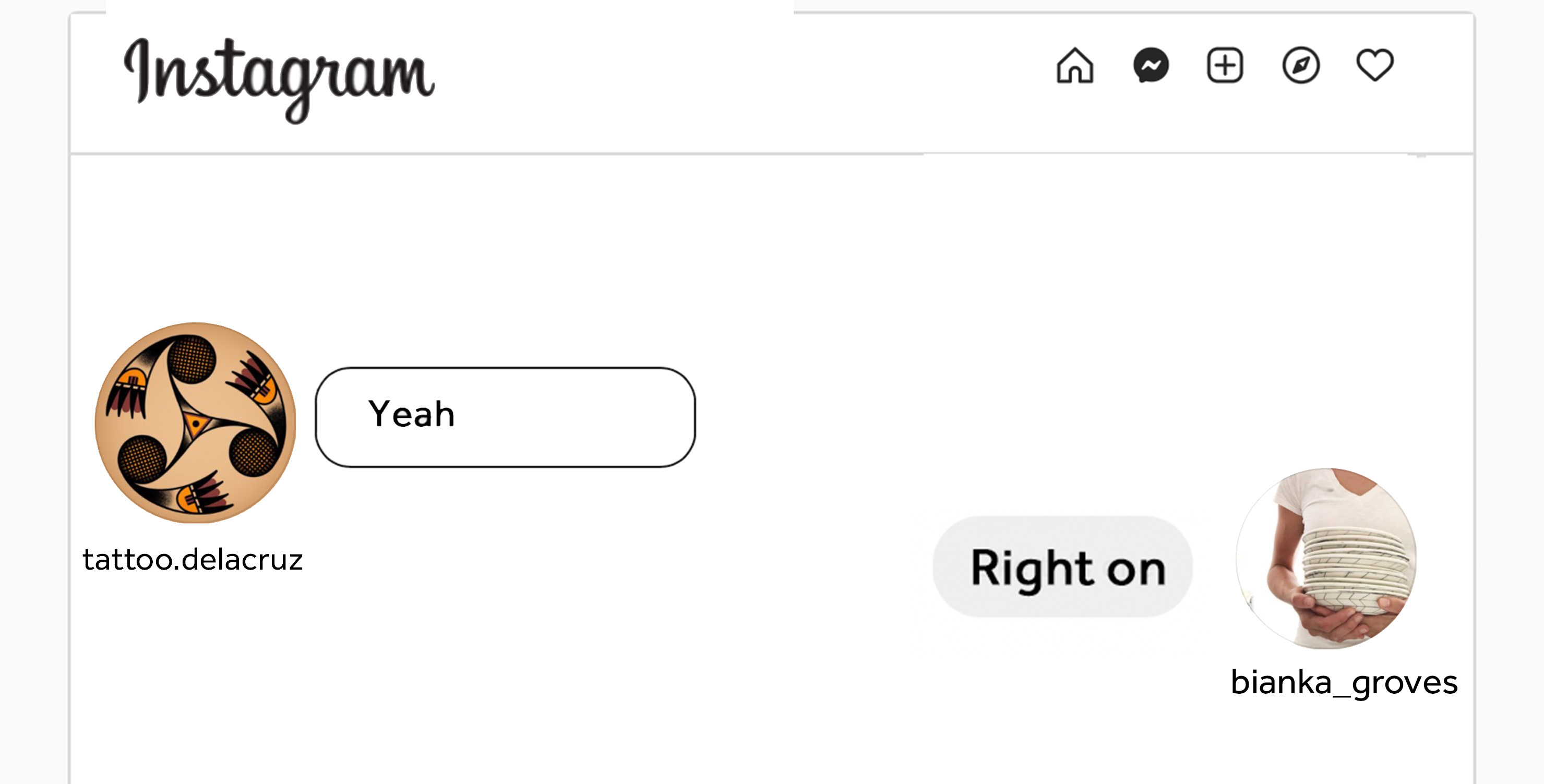
Then began:
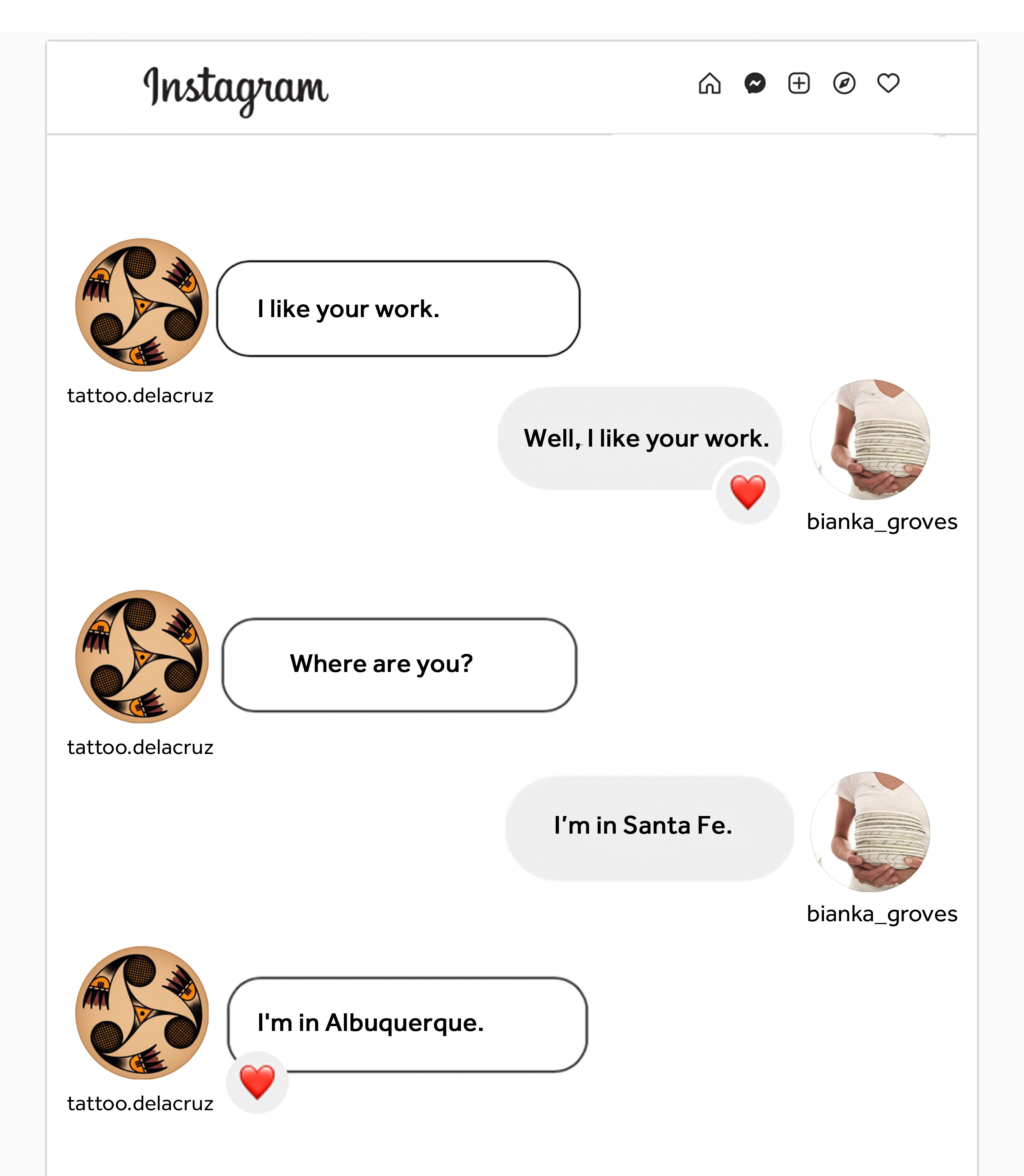
They talked about a tattoo for pottery trade.
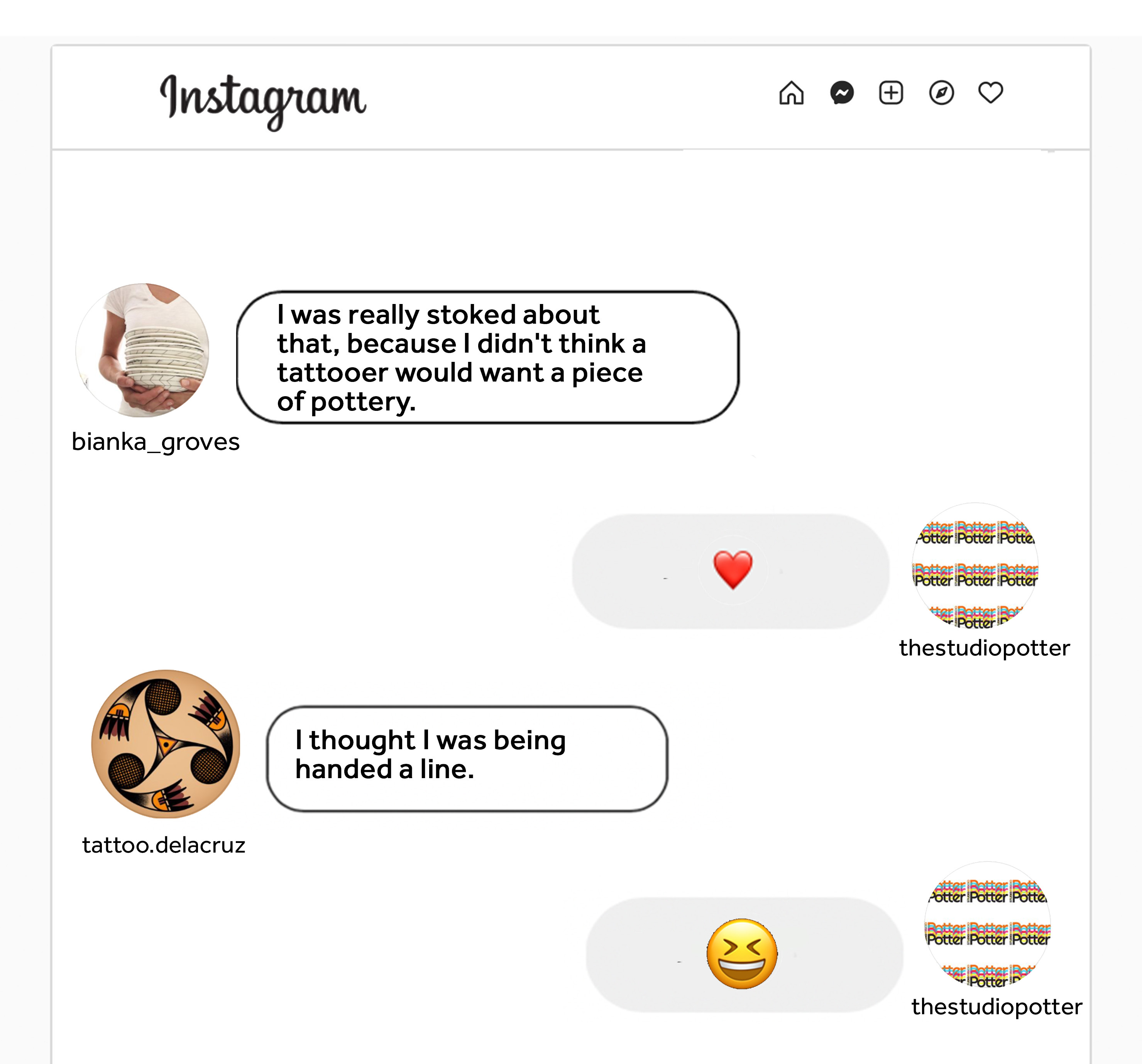
Bianka Groves: The more we started talking we realized we had a lot of stuff in common. When we were talking about tattoos, specifically about the tattoo he was going to do for me, he asked me a question no other tattoo artist had ever asked me before. Really, nobody else had ever asked me this question. The question was, “Is there something special or anything in particular I should be thinking about when I'm creating this piece for you?”
What I wanted was a rattlesnake in his style. A little rattlesnake of protection watching my back. I can't remember exactly what I said, but I did have a purpose for the tattoo. And he asked this question – you know I probably wasn't going to give him my concept for the tattoo, but he asked the question. I was blown away that he was tuned in to the meaning of what he does and what it means for his clients. I think about that all the time. The moment really stood out to me.
Studio Potter: And that let you know something about him as a person and a maker, what else drew you to want to collaborate artistically with Sonny?
BG: I have to be honest – I love the Southwest; I love New Mexico. To me, it's definitely the place where I feel most at peace and at home. But I've never really felt a connection with Southwest pottery. I admire it; I love to look at it, but I don't feel like it ever made its way into my brain when I first started developing my own style. With Sonny’s work, it does have that Southwest pottery aesthetic – a little bit, and
we never really talked about this, but what I liked is you [Sonny] have your own sense of style. Most ceramics artists in our community can look at a pot and tell either who made it, because we know, or who their instructor was in college, possibly because their work sometimes mimics who they learned from. I didn't know the same recognition also happens in tattooing. Sonny has his own developed style and it's unique. He's good at it. It's an aesthetic I haven't noticed in anybody else. When I think about my work and the similarities between inlay and tattooing, I thought there was a cool complement – one that would enable us to communicate back and forth.
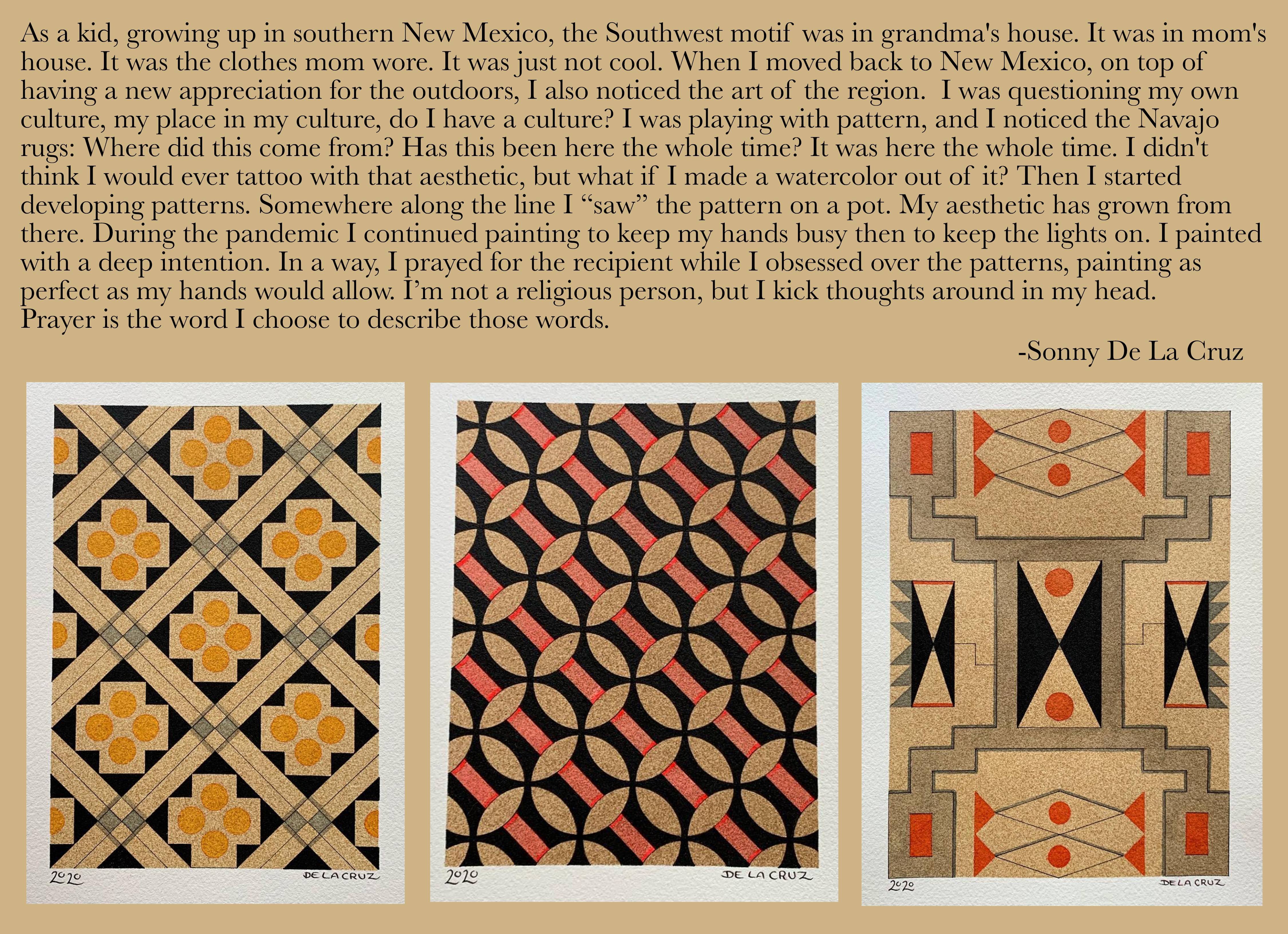
SP: And you Sonny, what draws you to the collaboration?
Sonny De La Cruz: When we first started communicating, Bianka told me she makes pots. I don’t think I understood what that meant initially. Now I understand and really like that, regardless of the form. She told me, “This is what I do, this is what I make.”
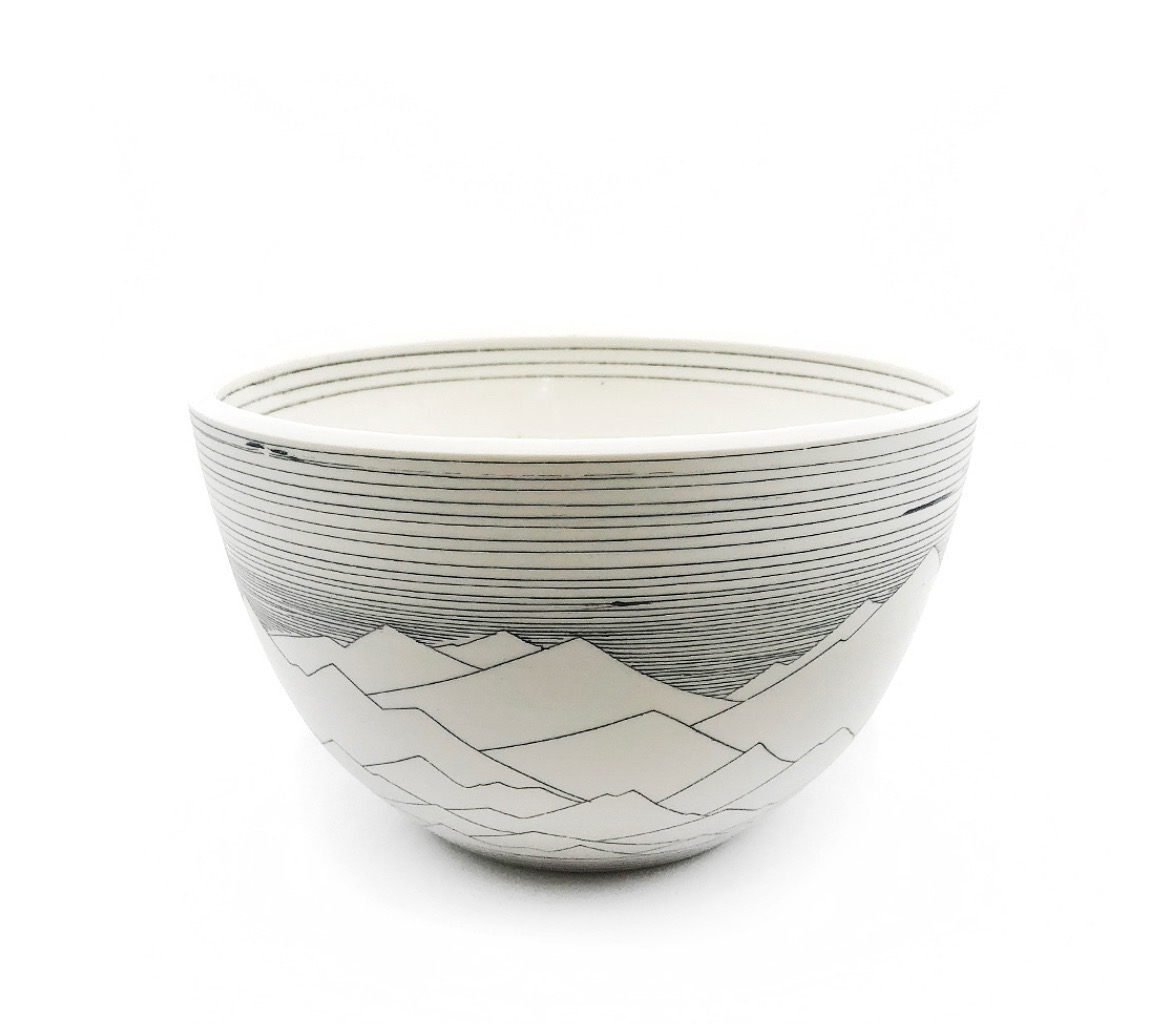
And I looked and … they're beautiful. They have an elegance to them. As someone outside the ceramic world, I fail to describe them. It is just exceptionally nice to take in the form, tone, and design of her pots. But initially I just looked at it and appreciated her work as art. It wasn't until my birthday, when she gave me a plate, that I was taken aback because – you know, she made it. She made the damn plate. I am positive I never ate from nor owned a handmade plate in my life. Sincerely, I don't know if I've ever told you [Bianka] that, but I'm sure of it. My mom bought ceramic ware, just basic, normal dishes. I never even had the idea of someone making the plate. Bianka said, when she gave me the plate, “Anything you eat tastes better, if you put it on this.” How cool is that? Basically, anything I know about ceramics I've learned over the past year, but I think I started noticing ceramics a lot more because it has had a second coming, third coming, whatever…
BG: Every ten years or so.
DLC: Yes, so its recent gain in popularity brought it into my view along with getting to know Bianka. Otherwise, I might have missed it. But I didn't know a single thing about ceramists. Learning about what materials they would want to work with and the processes they use – it all intermingles. Like what Bianka was saying about types of inlay and different ways you can make a mark on a pot. It mirrors the different ways you make a mark on a person, though you don't necessarily get to pick your material.
BG: You mean skin?
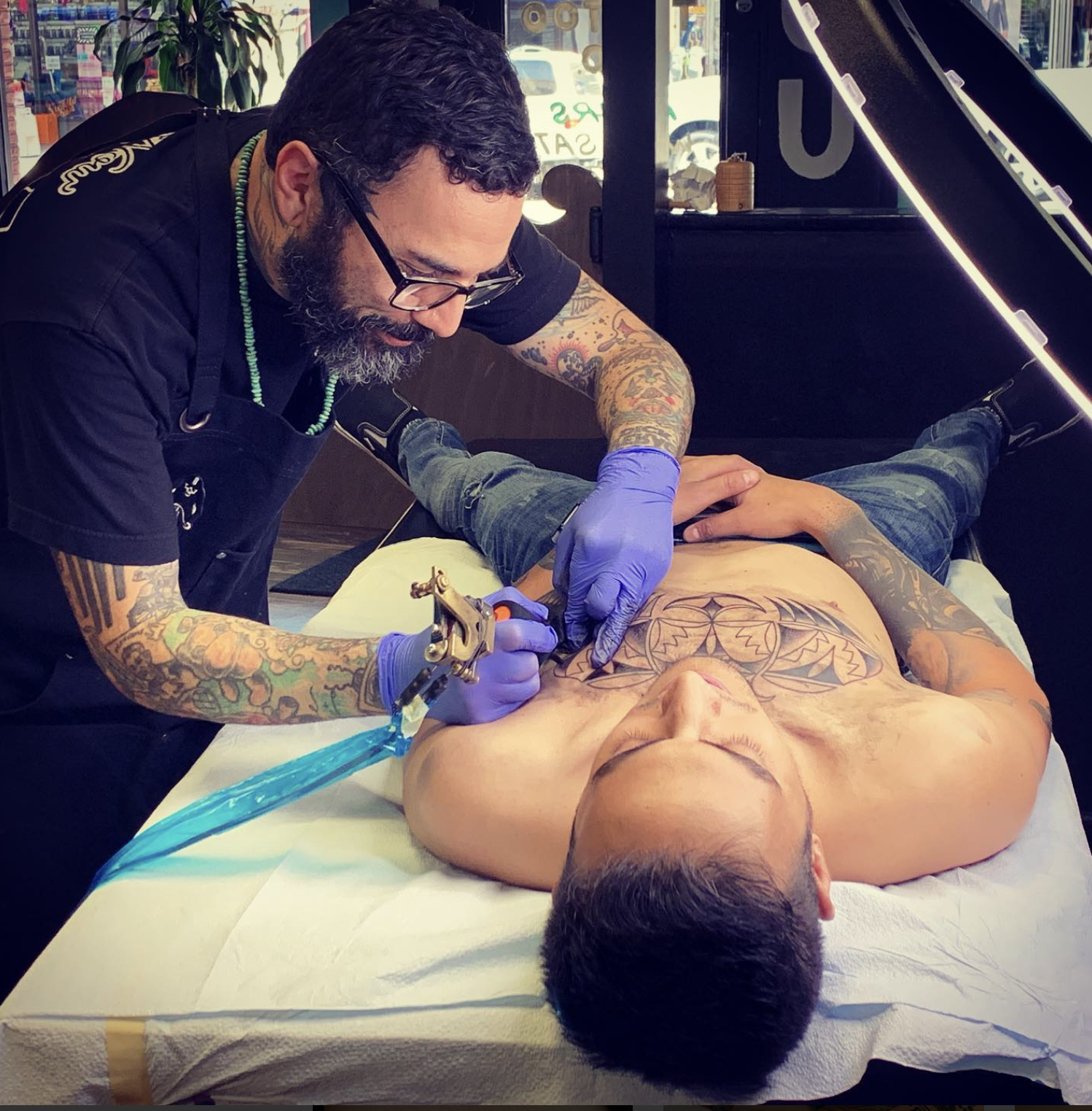 DLC: Yes, you don't get to pick the skin type. Like clay bodies there are variances among ethnicities and ages and health. Any one of those factors makes a big, big difference in how you tattoo. I find it highly interesting to see how a ceramist learns to work with different types of clay. I have my favorite skin type to work with.
DLC: Yes, you don't get to pick the skin type. Like clay bodies there are variances among ethnicities and ages and health. Any one of those factors makes a big, big difference in how you tattoo. I find it highly interesting to see how a ceramist learns to work with different types of clay. I have my favorite skin type to work with.
BG: What is it?
DLC: Light brown. I don’t want to distill human beings down to material, but light brown.
BG: Is it because of the color or because of…
DLC: A lot of things. Lighter brown skin tones are a lot more hydrated. They're oilier. The skin just retains its resilience. It can take a lot more, and you can work it a lot. Not aggressively, but you can put your elbow into it and lay some clean lines. The tone brings a richness to any sort of pigment even if you're not using color. It brings more value and contrast instantly.
BG: That makes total sense to me. I messed around a lot with photography in college, specifically with black and white prints. Whenever we would frame the image, our instructor would demand we use a semi, off-white matboard, just to make the black and white of the photograph pop more.
And this is how the conversation progressed, with a natural flow back and forth as we made note of the parallels between tattooing and pottery – as a craft, as a business, as global citizens who contribute to a larger conversation. It’s likely you may have laughed (or rolled your eyes) a moment ago when you read that Bianka told Sonny about the flavor properties handmade pottery would bring to his food; the three of us certainly did when it came up in our conversation. So, despite what was written in the opening paragraphs about eye-rolling at mottos, this motto was an opportunity to witness with humor the truth pithy wordplay can carry, even if the words have a tendency to flatten the depth of what inspired them to be written and repeated and repeated and repeated.
“Anything you eat tastes better, if you put it on this,” reminded Sonny about the many characters he encountered in his early days of working in tattoo street shops, “Old tattooers bordered on being carnies, always selling. Big personalities did extremely well in tattooing. If people enjoyed sitting down with you, then you worked more.”
As Sonny used the plate, he realized the truth in Bianka’s advertising.
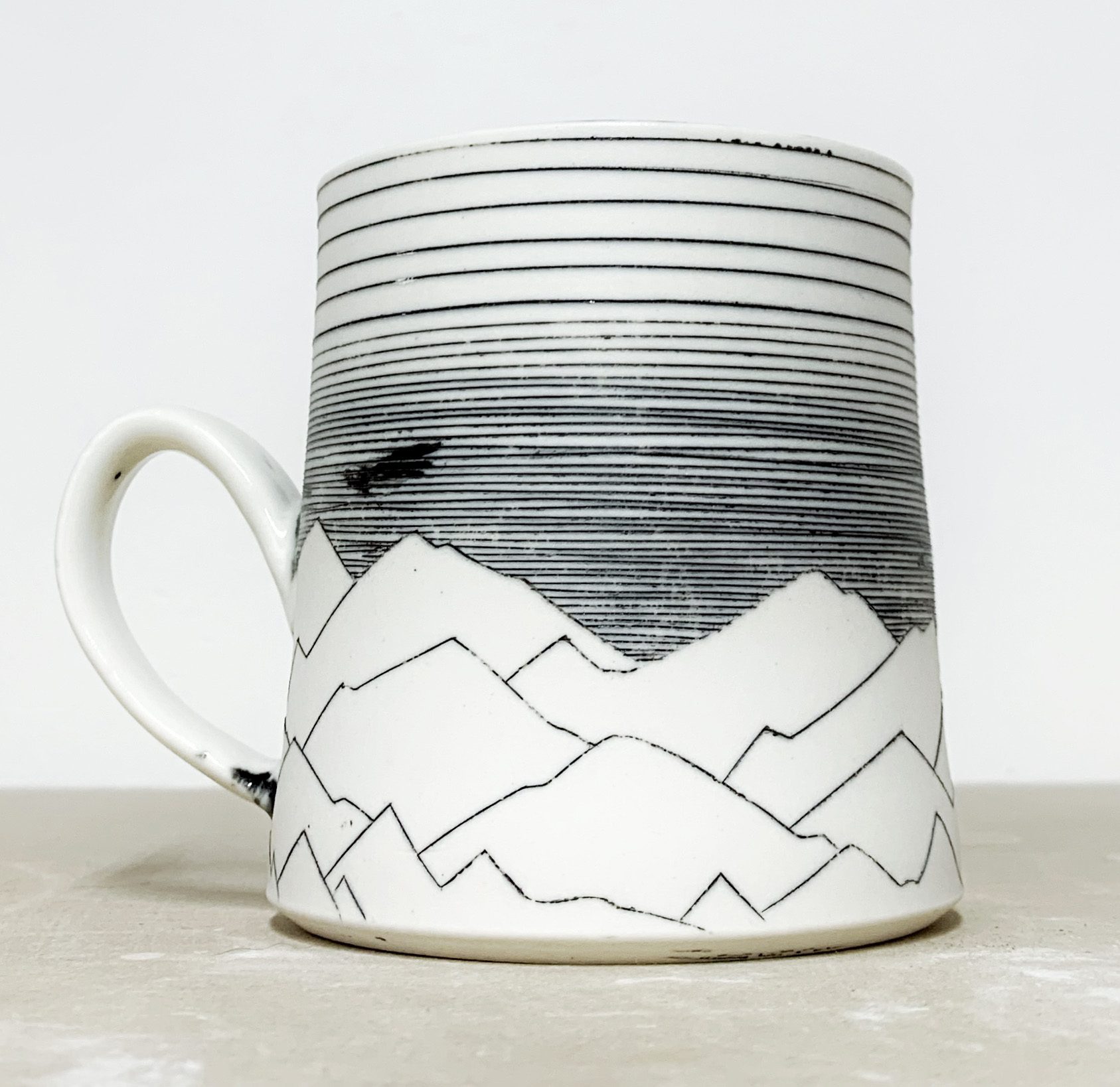 DLC: I thought it was great. I don't have a lot of dishes in my house. I live there by myself. I used that one plate for almost a solid week. Each night when I prepared my grilled cheese, fish sticks or whatever, it was this plate I'd see sitting underneath my food. That one-liner would ring through my head and then I would start considering different things. First off: she made this! You know what I mean? With her with her hands! She made this and that's friggin’ awesome. Then I would go deeper and think, “People have been making the pots I've been inspired by for generations. People made the pots that have completely influenced the entire aesthetic of my drawings and paintings. The people were what was missing from what I was looking at in books or images of surface designs I look at on my phone. I was never really considering the human sitting outside, forming this thing, and then throwing it into fire. Contemplating the process of pots started to blow my mind – the handmade factor. I think that's what appeals to me about what I do, whether it's painting or tattooing, I’m using my hands. Now we have this – it's not an argument – it's just us throwing the admiration back and forth where I say, “What you do is so much cooler than what I do.” It is so much cooler to make a cup. I got a cup later on; it’s a coffee cup. To use that cup again and again and again, I think it’s the function that makes it cooler. What I do doesn't have a function. And that's where she chimes in and says, “Yeah it does.” And I reply, “But not a practical function.”
DLC: I thought it was great. I don't have a lot of dishes in my house. I live there by myself. I used that one plate for almost a solid week. Each night when I prepared my grilled cheese, fish sticks or whatever, it was this plate I'd see sitting underneath my food. That one-liner would ring through my head and then I would start considering different things. First off: she made this! You know what I mean? With her with her hands! She made this and that's friggin’ awesome. Then I would go deeper and think, “People have been making the pots I've been inspired by for generations. People made the pots that have completely influenced the entire aesthetic of my drawings and paintings. The people were what was missing from what I was looking at in books or images of surface designs I look at on my phone. I was never really considering the human sitting outside, forming this thing, and then throwing it into fire. Contemplating the process of pots started to blow my mind – the handmade factor. I think that's what appeals to me about what I do, whether it's painting or tattooing, I’m using my hands. Now we have this – it's not an argument – it's just us throwing the admiration back and forth where I say, “What you do is so much cooler than what I do.” It is so much cooler to make a cup. I got a cup later on; it’s a coffee cup. To use that cup again and again and again, I think it’s the function that makes it cooler. What I do doesn't have a function. And that's where she chimes in and says, “Yeah it does.” And I reply, “But not a practical function.”
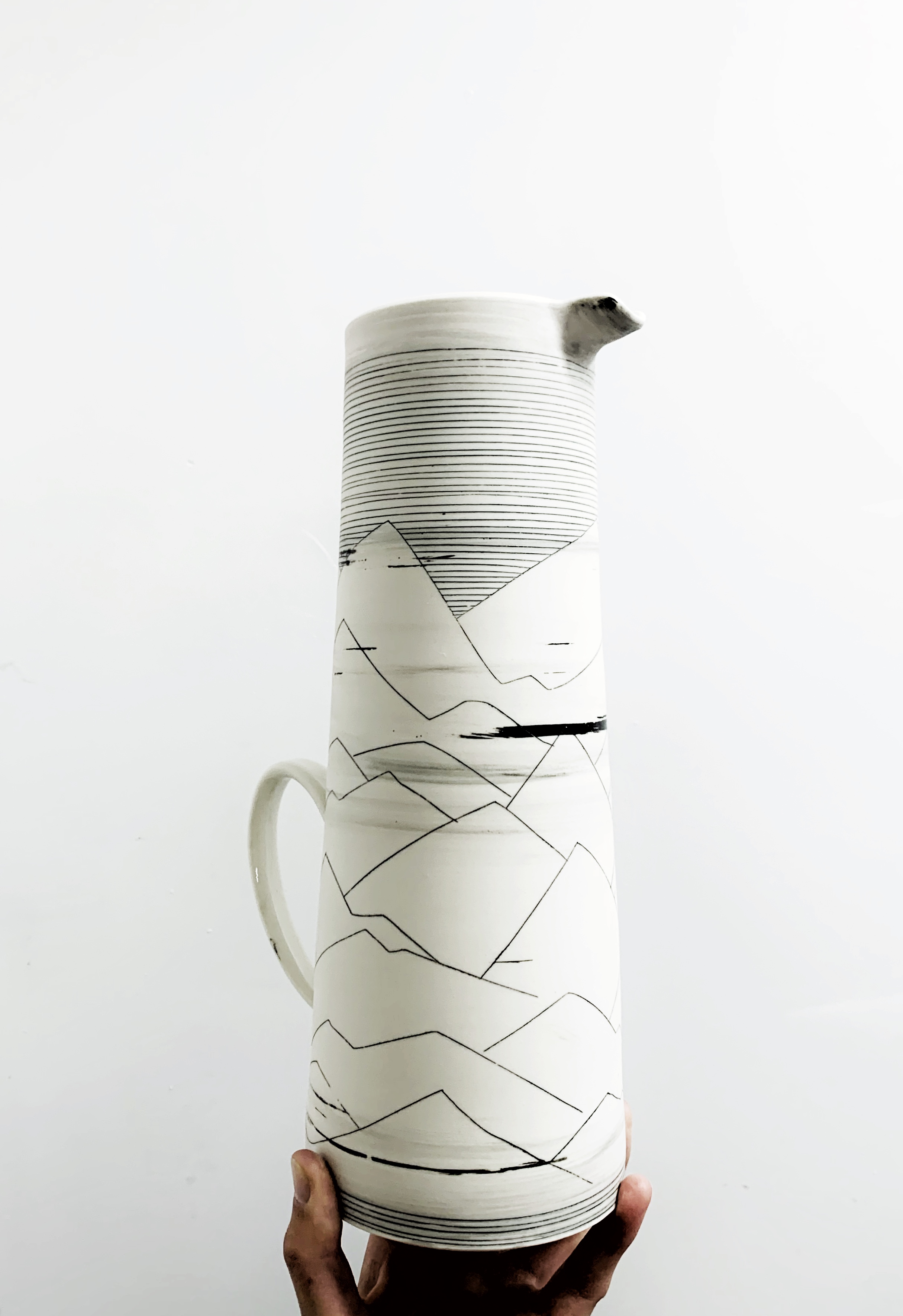 BG: You’re wrong.
BG: You’re wrong.
SP: For someone who asked about setting an intentional mindset before beginning a tattoo, it surprises me that you would say a tattoo doesn’t have a function.
Before Sonny could jump in to defend his position (although it should be pointed out he was chuckling at the discrepancy more than posturing a defense), I asked Bianka to address what she perceived as the function of a tattoo – beyond decoration.
BG: Well, I think ironically, the function of a tattoo – for me and I think for a lot of people – is healing. It's an intentional wound, but it's healing. I think most of … I don't know how many I have. I know it's more than ten less than twenty, but the majority of my tattoos were therapeutic and therapeutic meaning some of them were just out of pure happiness, or maybe I just overcame some kind of a mental block I had, that I had been struggling with, or a situation in my life that I conquered, or just even – f-you, I'm getting this tattoo. It’s always a mental form of healing.
SP: Sonny, I find it hard to believe you can’t agree with that interpretation of function.
DLC: And I don't disagree. I remember you [Bianka] saying that last time we were talking about this. No, I absolutely don't disagree; you're absolutely right. That is why I do what I do, so I can do more for someone than just mark their body. Honestly, I don't know where the concept [of intentionality] came from or when it came to me. It’s like it I just showed up one day and I realized, “This is what I'm doing.”
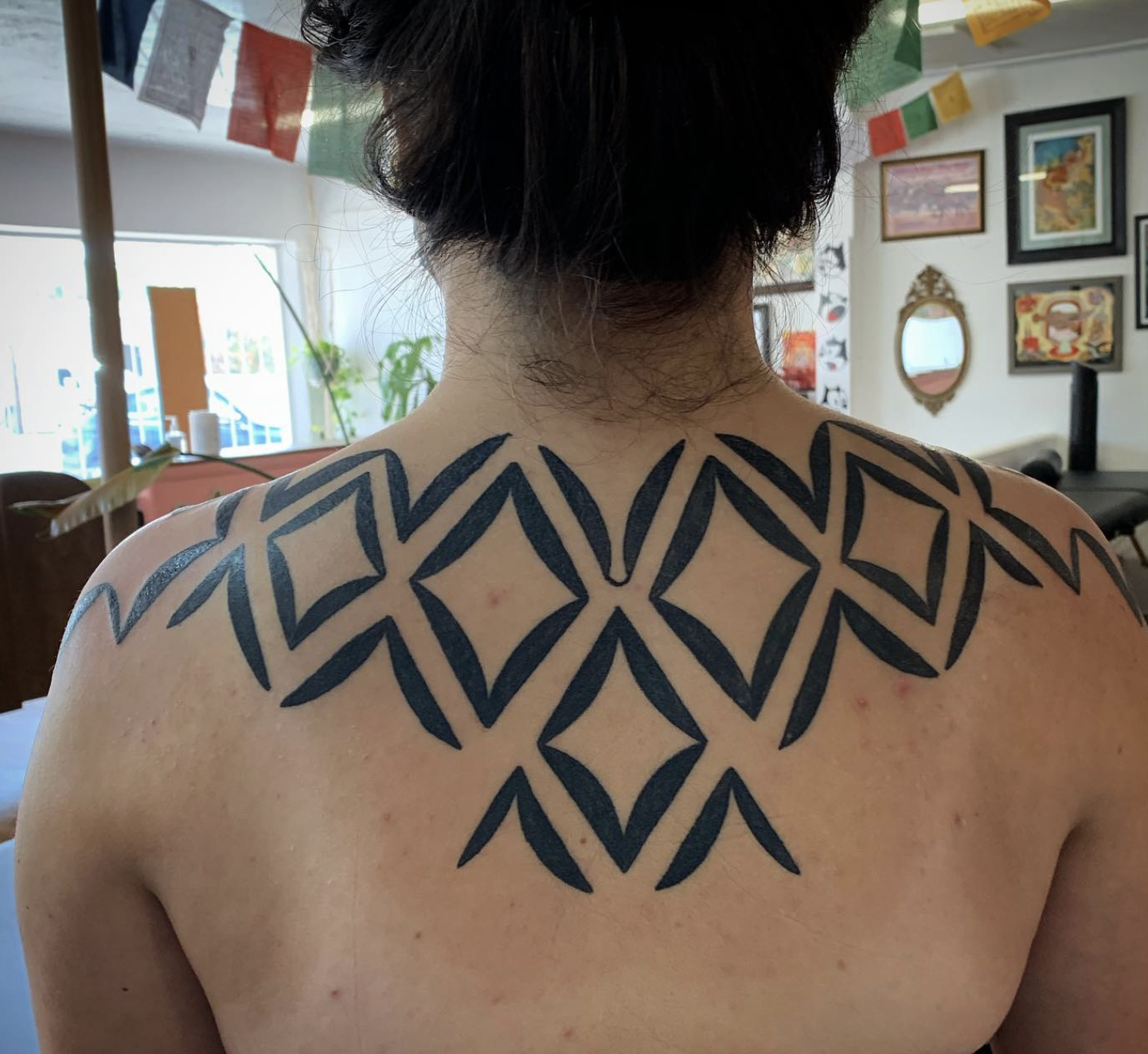 Actually, this huge "aha!" moment came to me through conversations with
Actually, this huge "aha!" moment came to me through conversations with
clients who have said things like what Bianka just said. Anything from the cheesy guy saying, “I need some ink therapy,” to someone sitting down and telling me a deeply specific trauma. People open up, they drop their guard and start talking. Sometimes it's a little more than I can handle – not in a bad way, but I go home, and I'm still mulling over what the client shared. They're gone, but emotionally it lingers; it sticks with me. I'm not completely insensitive when someone sits down and tells me their woes. It’s real. It's humanity touching me.
So, no, I don't disagree with that idea of functionality regarding tattoos. But I think … I guess maybe – to get weird on you – is I'm on a specific plane of reality when I’m talking about the use and function of a handmade object; not the mental plane, but the plane where I am grabbing a cup and delivering it to my mouth or putting food on a plate. The fact that pottery occupies space in time – I think is really f-ing cool. Because from there, where does it go?
SP: Where does it go from here? This question makes me want to ask you about permanence and how each of you perceives the permanence of your craft. Ceramic objects take millennia to return to clay, to go through the alluvial process, some say that is “forever.” Tattoos are a conscious choice to mark your body for life, another perspective on “forever.” Where do you two sit on the matter of forever?
BG: I think I can argue for all sides, meaning arguing for the permanence of skin and the permanence of clay. There have been archaeological discoveries of humans – I don't know, five- or six-thousand-years-old – with tattoos still. Preserved because they're frozen in ice. That's one form of permanence, but that's rare. The other thing with ceramics is … I've always been a junkie for cool rocks, cool sticks, any piece of detritus I find on the floor or in nature: arrowheads, rocks, pot shards, vintage cans, or anything. When I moved to New Mexico I started exploring by driving as far as I could drive, and then I’d park. Then I’d get out and I’d walk. Usually it's not on trails, it's all on public land or in the national forest. I don't see people. I find random objects. Often, I find little shards of pots. The more I learned about it … there are sacred sites, where people, thousands of years ago, would have ceremonies. They would break their pottery in these ceremonies. That's often why you find massive amounts of broken shards. They are historic. They are beautiful. They are not mine. They don’t belong to me. But the analytical part of my brain says that this is just the garbage of the future. Garbage landfills have been excavated by archeologists for at least one-hundred, maybe going on two-hundred years.
DLC: That's the place to dig.

BG: Yeah, it's the place to dig. It's where you find the most information about what was going on in that culture in that community at that time. When I find a pot shard, I can see what part of the piece it was – the lip or the foot or whatever. But the impermanence of it is that it's human-made. These people [who made the pots] are special in one way, but they're not special in another way – meaning that this is just their broken garbage. Maybe not, it might have been a ceremonial ball or something like that, but it could have just been a bowl to carry something foraged to a different location, I don't know. But in five-thousand years, if there are humans around, they're going to pick up garbage that we leave behind. It could be a pot that Sonny and I make. So the idea of permanence … can there be a short-lived permanence? Could that be a thing? Because it could be permanent in our life or our lifetime? But…
DLC: That was part of a conversation we had before when I saw some things she had found, and I wanted to know where so I could find some too. She described this mix of feelings between something special and something mundane. You find arrowheads in the desert, and you also find spent shotgun shells. I can make a leap and equate the conversation on the impermanence of the permanent to when people come in to get tattooed and say (not to sound jaded, but many people say the same stuff when they go into a tattoo shop), “I don't know what I would get. It's so permanent.” They get so hung up on the decision. It's such a big deal – you're marking yourself for life. There are a number of things I say in response.
“They're not permanent anymore. They shoot those off with lasers.”
Worried about what the tattoo is going to be like when you're an old lady?
“Who says you'll make it that far?”
When people ask me about infections? I don't know, maybe it's a reach, but when people ask, “What if it gets infected?”
Tattoos don't get infected unless you're a very dirty person. If you don't wash it, at least every couple of days. You have a better chance of walking out there and getting hit by the city bus than you do getting an infection on this tattoo.
I try to bring in the idea of mortality. It's not permanent, and you know, you can cover it up and get another one if you don't like that one. It's just not that big of a deal. Where just a moment ago we were talking about the medicine of tattoos and the therapeutic benefits, but it's just momentary.

These shards of our conversation, preserved in text, I will carry them into my own impermanent interpretations of life with gratitude. Specific to these two artists, as I look at their objects and images I will see the quiet stillness of the desert, the insignificance of our existence, the joy of laughing at ourselves and our conclusions, and most important: the solid strength and permanence of time that will continue beyond knowing. Art continues to allow us all to transcend the plane of function and contemplate the healing. But don’t sit there smiling beatifically for too long, we’ve all got to get back to the work eventually. Without the work, we might lose our perspective.
DLC: A good street-shop artist can do everything. I've known maybe four or five tattooers that can do everything and knock it right out of the park. Spending fifteen or sixteen years in that environment was where I got serious, practicing different styles, concentrating hard on taking an idea and making a decent tattoo out of it – a decent visual. I was serious about applying the image and achieving technical superiority. What makes a good tattooer is someone who can put in a clean tattoo with a nice solid field of color or black with clean lines, applied on the body so it doesn’t look like a dark stamp. You do those tattoos every single day.
BG: I love the standard cylinder. It's such a basic shape. But they're the foundation. If you chop it in half, you'll see the proportions, the mechanics. You’ve got to have it [in your repertoire]. You have to know how to make a good, boring pot.
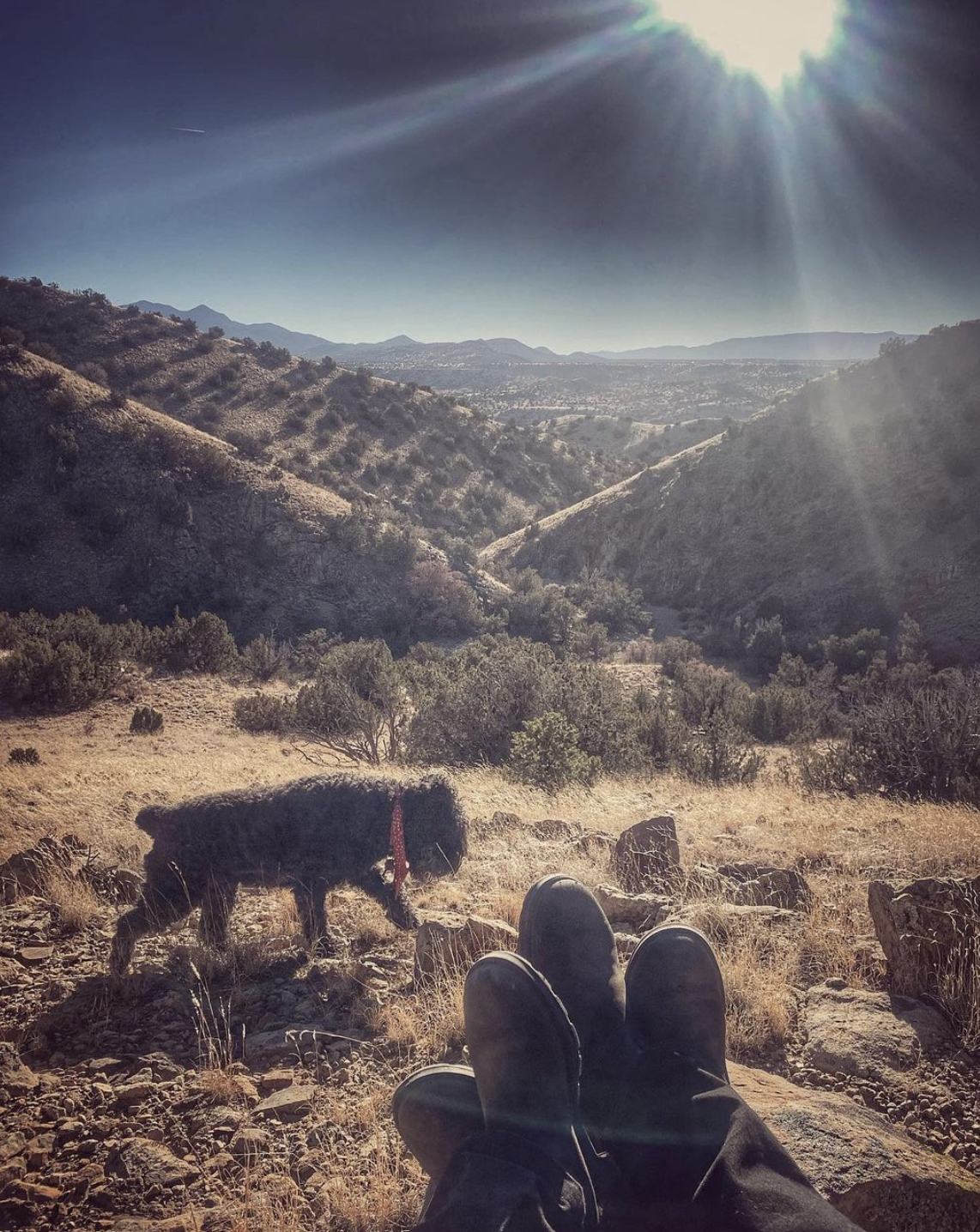
All images provided courtesy of Bianka Groves and Sonny De La Cruz.

